Kawasaki Ninja ZX workshop manual
The Kawasaki Ninja ZX-14, are a bike within the Ninja recreation bicycle series from Japanese producer Kawasaki that has been their particular most effective sport bike since 2007.
The bike was in season 10 of Fifth equipment on October 30, 2006.
Bike
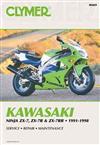
Softcover - 650 pages - Kawasaki Ninja ZX-7 ZX-7R ZX-7RR 1991 - 1998 Clymer Owners Service Repair Manual Covers the following Models: Ninja ZX-7 J1 J2 (U.S. Canada and U.K.) (1991-1992) Ninja ZX-7R K1 K2 (U.S. Canada and U.K.) (1991-1992) Ninja ZX-7 L1 L2 L3 (U.S. Canada and U.K.) (1993-1995) Ninja ZX-7R M1 M2 (U.S. Canada and U.K.) (1993-1994) Ninja ZX-7RR N1 (U.S. Canada and U.K.) (1996) Ninja ZX-7R P1 P2 P3 (U.S. Canada U.K. and Europe) (1996-1998)Contents: QUICK REFERENCE DATA GENERAL INFORMATIONManual organization / Notes cautions and warning / Safety first / Washing the bike/ Torque specifications / Special tips / Fasteners / Lubricants / Threadlocking compound / Expendable supplies / Serial numbers / Warning and in
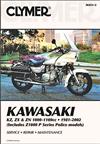
Softcover - 360 pages - Kawasaki KZ ZX ZN 1000 1100cc Fours 1981 - 2002 Clymer Owners Service Repair Manual covers the following models:U.S. and Canada Models KZ1000 J1 J2 (1981-1982) KZ1000 K1 K2 LTD (1981-1982) KZ1000 M1 M2 CSR (1981-1982) KZ1000 R1 R2 Replica (1982-1983) KZ1100 A1 A2 A3 Standard (1981-1983) KZ1100 B1 B2 GP (1981-1982) KZ1100 D1 D2 Spectre (1982-1983) KZ1100 L1 LTD Shaft Drive (1983) ZX1100 A1 A2 (1983-1984) ZN1100 B1 B2 (1984-1985) Z10000 Police Model P1-P21 (1982-2002)Other than U.S. and Canada Models Z1000 J1 J2 (1981-1982) Z1000 K1 K2 (1981-1982) Z1100 A1 A2 (1981-1982) Z1100 B1 B2 (1981-1982) Z1000 J3 (1983) Z1000 R2 (1983) Z1100 D2 (1983) Z1100 A1 A2 (1983-1984) Z1100 A3 (1985)Contents: QUICK REFERENCE DATA GENERAL INFORMATIONManual organization / Service hints / Safety first / Expendable supplies / Shop tools / Emergency tool kit / Troubleshooting and tune-up equipment / Specifications TROUBLESHOOTINGStarting difficulties / Poor performance / Clutch and transmission / Drive train / Chassis / Brakes / Electrical system / Charging system / Lighting / Fuses / Wiring / Specifications LUBRICATION MAINTENANCE AND TUNE-UPModel identification / Scheduled m
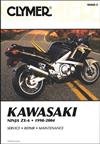
Softcover - 624 pages - Kawasaki Ninja ZX6 ZX600 ZZ-R 600 1990 - 2004 Service Repair Manual Covers the following models: ZX600 D (U.S. and Canada) (1990-1993) ZX600 E (U.S. and Canada) (1993-2004) ZZ-R600 D (U.K) (1990-1993) ZZ-R600 E (U.K.) (1993-2003)Contents: QUICK REFERENCE DATA GENERAL INFORMATIONManual organization / Notes cautions and warnings / Safety first / Service hints / Torque specifications / Special tips / Fasteners / Lubricants / Threadlocking compound / Expendable supplies / Warning and information labels / Basic hand tools / Precision measuring tools / Special tools / Fabricating tools / Mechanic #39;s tips / Ball bearing replacement / Seals / Riding safety / Storage / Specifications TROUBLESHOOTINGOperating requirements / Troubleshooting instruments / Starting the engine / Starting difficulties / Engine starting system / Charging system / Ignition system / Fuel system / Engine overheating / Engine / Engine noises / Cylinder leakage test / Clutch / Transmission / Drive train noise / Handling / Frame noise / Brakes LUBRICATION MAINTENANCE AND TUNE-UPPre-ride c
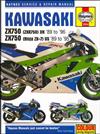
Softcover - 288 pages - Kawasaki Ninja ZX7 ZX750 ZXR750 1989 - 1996 Haynes Owners Service Repair Manual covers the following models:UK Models: ZX750H (ZXR750) 748cc 1989 - 1990 ZX750J (ZXR750) 749cc 1991 - 1992 ZX750L (ZXR750) 749cc 1993 - 1996 ZX750K (ZXR750R) 749cc 1991 - 1992 ZX750M (ZXR750) 749cc 1993 - 1994USA Models: ZX750H (Ninja ZX-7) 748cc 1989 - 1990 ZX750J (Ninja ZX-7) 749cc 1991 - 1992 ZX750L (Ninja ZX-7) 749cc 1993 - 1995 ZX750K (Ninja ZX-7R) 749cc 1991 - 1992 ZX750M (Ninja ZX-7R) 749cc 1993 - 1994Note: the Kawasaki ZX750F (Ninja 750R or GPX750 R) is covered in Haynes Manual HM1780Contents: Kawasaki Zx750 Maintenance Introduction- Buying Parts- Engine Oil Level- Brake Fluid Levels- Tyres- Routine Maintenance
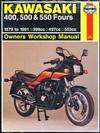
Softcover - 260 pages - Kawasaki Z400 ZR400 ZX400 Z500 KZ500 KZ550 GPz550 ZX550 1979 - 1991 1979 - 1991 Haynes Owners Service Repair Manual Covers the following models:UK Models: Z400J 399cc 1980 - 1983 ZR400 (Z400F) 399cc 1983 - 1985 ZX400 (Z400FII) 399cc 1984 - 1987 Z500B 497cc 1979 - 1980 Z550A 553cc 1980 - 1983 ZR550 (Z550F) 553cc 1982 - 1987 Z550C (LTD) 553cc 1980 - 1983 Z550D (GPz550) 553cc 1981 - 1982 Z550H (GPz550) 553cc 1982 - 1983 ZX550 (GPz550) 553cc 1983 - 1991 Z550G (GT550) 553cc 1983 - 1991USA Models: KZ550A 553cc 1980 - 1983 KZ550C (LTD) 553cc 1980 - 1983 KZ550D (GPz550) 553cc 1981 KZ550H (GPz550) 553cc 1982 - 1983 ZX550 (GPz550) 553cc 1984 - 1985 KZ550F (Spectre/LTD) 553cc 1983 - 1984 KZ550M (LTD) 553cc 1983Contents: Introduction To The Kawasaki 400 500 And 550 Fours Maintenance Engine Clutch And Transmission Fuel System And Lubrication Ignition System Frame And Forks Wheels Brakes And Tyres Electri
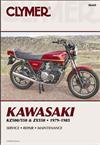
Softcover - 352 pages - Kawasaki KZ500 KZ550 ZX550 1979 - 1985 Clymer Owners Service Repair Manual covers the following Models: Kawasaki KZ500-B1 1979-1981 (US Canada Europe) Kawasaki KZ500-B4 1982-1983 (except US Canada) Kawasaki KZ550-A1 A2 1980-1981 (US Canada) Kawasaki KZ550-A3 1982-1983 (US Canada Europe) Kawasaki KZ550-B2 1979-1981 (Europe) Kawasaki KZ550-B2 1981 (US Canada Europe) Kawasaki KZ550-C1 1980 (US Canada Europe) Kawasaki KZ550-C2 1981 (US Canada Europe) Kawasaki KZ550-C3 1982-1983 (US Canada Europe) Kawasaki KZ550-D1 1981 (US Canada Europe) Kawasaki KZ550-F1 1982-1983 (US Canada) Kawasaki KZ550-H1 1982-1983 (US Canada Europe) Kawasaki KZ550-M1 1982-1983 (US Canada) Kawasaki ZX550-A1 A2 1984-1985 (US Canada Europe)Contents: QUICK REFERENCE DATA GENERAL INFORMATIONManual organization / Service hints / Safet
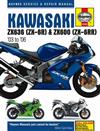
Hardcover - 304 pages - Kawasaki Ninja ZX636 ZX-6R ZX600 ZX-6RR 2003 - 2006 Haynes Owners Service Repair Manual Covers the following models:NINJA ZX-6R Ninja ZX636B1 2003 Ninja ZX636B2 2004 Ninja ZX636C1 2005 Ninja ZX636C6 2006NINJA ZX-6RR Ninja ZX600K1 2003 Ninja ZX600M1 2004 Ninja ZX600N1 2005 Ninja ZX600N6 2006Contents: Living With Your KAWASAKI NINJA ZX-6R and ZX-6RR Introduction- Kawasaki: The Green Machines- About This Manual- Safety First!- Identification Numbers- Buying Parts Pre-Ride Checks- Coolant Level- Engine Oil Level- Brake Fluid Levels- Suspension Steering And Drive Checks- Legal And Safety Checks- Tyres Maintenance- Routine Maintenance And Servicing- Specifications- Lubricants And Fluids- Maintenance Schedule- Component Locations- Maintenance Procedures Repairs And Overhaul- Engine Transmission And Associated Systems- Engine Clutch And Transm
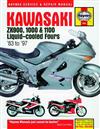
Hardcover - 248 pages - Kawasaki ZX900 1000 1100 Liquid-cooled Fours 1983 - 1997 Haynes Owners Service Repair Manual covers the following models:UK Models: ZX900A (GPZ900R) 908cc 1984 - 1996 ZX1000A (GPZ1000RX) 997cc 1985 - 1989 ZX1000B (ZX-10) 997cc 1987 - 1991 ZX1100C (ZZ-R1100) 1052cc 1990 - 1992 ZX1100D (ZZ-R1100) 1052cc 1992 - 1997USA Models: ZX900A (Ninja) 908cc 1983 - 1986 ZX1000A (Ninja 1000R) 997cc 1985 - 1987 ZX1000B (Ninja ZX-10) 997cc 1988 - 1990 ZX1100C (Ninja ZX-11C) 1052cc 1990 - 1993 ZX1100D (Ninja ZX-11D) 1052cc 1993 - 1997Contents: Maintenance Engine Clutch And Transmission Fuel System And Lubrication Ignition System Frame And Forks Wheels Brakes And Tyres Electrical System Wiring Diagrams
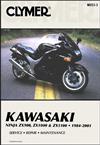
Softcover - 610 pages - Kawasaki Ninja ZX900 ZX1000 ZX1100 1984 - 2001 Clymer Owners Service Repair Manual Covers the following Models: Ninja ZX900 A1-A3 (1984-1986) Ninja ZX1000 A1-A2 (1986-1987) Ninja ZX1000 (ZX-10) B1-B3 (1988-1990) Ninja ZX1100 C1-C4 (1990-1993) Ninja ZX1100 (ZX-11) D1-D9 (1993-2001)Contents: QUICK REFERENCE DATA GENERAL INFORMATIONManual organization / Notes cautions and warnings / Safety first / Service hints / Torque specifications / Fasteners / Lubricants / Parts replacement / Basic hand tools / Test equipment / Mechanic #39;s tools / Specifications TROUBLESHOOTINGoperating requirements / Troubleshooting instruments / Starting the engine / Emergency troubleshooting / Engine st
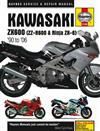
Hardcover - 248 pages - Kawasaki ZX600 (ZZ-R600 Ninja ZX-6) 1990 - 2006 Haynes Owners Service Repair Manual Covers the following models:UK Models: ZX600D (ZZ-R) 599cc 1990 - 1993 ZX600E (ZZ-R) 599cc 1993 - 2006USA Models: ZX600D (ZX-6) 599cc 1990 - 1993 ZX600E (Ninja ZX-6) 599cc 1993 - 2002 ZX600E (ZZ-R600) 599cc 2003 - 2004Note: this manual DOES NOT cover the U.S. market 2005-on ZX600J (ZZ-R600)Contents: Kawasaki ZX600 Ninja Maintenance Routine Maintenance And Servicing- Specifications- Recommended Lubricants And Fluids- Maintenance Schedule- Component Locations- Maintenance Procedures Kawasaki ZX600 Ninja Repairs And Overhaul Engine Transmission And Associated Systems- Engine Clutch And Transmission- Cooling System- Fuel And Exhaust Systems- Ignition System Chassis Components- Suspension And Steering- Final Drive- Brakes- Tyres- Fairing Bodywork And Frame Electrical System- Wiring Diagrams Reference- Dimensions And Weights- Tools And Workshop Tips- Sto
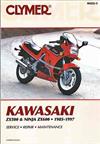
Softcover - 330 pages - Kawasaki ZX500 ZX600 Ninja 1985 - 1997 Clymer Owners Service Repair Manual Covers the following models: ZX500 (Europe) (1985-1990) Ninja ZX600A (1985-1987) Ninja ZX600C (1988-1997)Contents: QUICK REFERENCE DATA GENERAL INFORMATIONManual organization / Notes cautions and warnings / Service hints / Safety first / Torque specifications / Fasteners / Lubricants / Parts replacement / Basic hand tools / Test equipment / Mechanic #39;s tips /Specifications TROUBLESHOOTINGOperating requirements / Troubleshooting instruments / Emergency troubleshooting / Engine starting / Engine performance / Engine noises / Engine lubrication / Clutch /Transmission / Charging system / Starting system / Electrical problems / Ignition system /Excessive vibration / Carburetor troubleshooting / Front suspension and steering / Brake problems PERIODIC LUBRICATION MAINTENANCE AND TUNE-UPRoutine checks / Maintenance intervals / Tyres / B
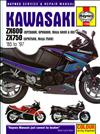
Hardcover - 264 pages - Kawasaki ZX600 ZX750 Fours 1985 - 1997 Haynes Owners Service Repair Manual Covers the following models:UK Models: ZX600A (GPZ600R) 592cc 1985 - 1990 ZX600C (GPX600R) 592cc 1988 - 1996 ZX750F (GPX750R) 748cc 1987 - 1991USA Models: ZX600A (Ninja 600R) 592cc 1985 - 1987 ZX600B (Ninja 600RX) 592cc 1987 ZX600C (Ninja 600R) 592cc 1988 - 1997 ZX750F (Ninja 750R) 748cc 1987 - 1990Contents: Kawasaki Ninja Maintenance Introduction- Buying Parts- Engine Oil Level- Brake Fluid Levels- Tyres- Routine Maintenance And Servicing- Specifications- Maintenance Schedule- Component Locations- Maintenance Procedures Repairs And Overhaul- Engine Transmission And Associated Systems- Engine Clutch And Transmission- Cooling System- Fuel And Exhaust Systems- Ignition System Chassis Components- Frame Suspension And Final Drive- Brakes- Wheels- Tyres- And Bodywork Electrical System- Wiring Diagrams
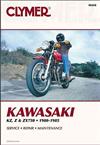
Softcover - 366 pages - Kawasaki KZ750 Z750 ZX750 1980 - 1985 Service Repair Manual Covers the following Models: KZ750E (1980-1985) KZ750H (1980-1985) KZ750L (1980-1985) KZ750LTD (1980-1985) KZ750R (1980-1985) Z750L (1980-1985) ZX750A (1980-1985) ZX750E (1980-1985)Contents: QUICK REFERENCE DATA GENERAL INFORMATIONManual organization / Service hints / Safety first / Expendable supplies / Shop tools / Emergency tool kit / Troubleshooting and Tune-up equipment / Specifications TROUBLESHOOTINGStarting difficulties / Poor performance / Drive train / Chassis / Brakes / Electrical system / Charging system / Lighting / Fuses / Wiring LUBRICATION MAINTENANCE AND TUNE-UPMaintenance schedule / Battery / Engine oil and filter change / General lubrication / Throttle cable lubrication / Drive chain lubrication / Clutch adjustment / Drive chain / Front fork oil level check and fluid change / ear shock absor
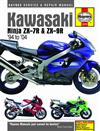
Hardcover - 248 pages. - Kawasaki Ninja ZX-7R ZX-9R 1994 - 2004 Haynes Owners Service Repair Manual Covers the following models: Kawasaki Ninja ZX7R (ZX750P) 1996 - 2003 Kawasaki Ninja ZX9R (ZX900B) 1994 - 1997 Kawasaki Ninja ZX-9R (ZX900C) 1998 - 1999 Kawasaki Ninja ZX-9R (ZX900E) 2000 - 2001 Kawasaki ZX-9R (ZX900F ) 2002 - 2004Contents: Living With Your KAWASAKI NINJA- Introduction- Identification numbers- Buying spare parts- Daily (pre-ride) checks- Engine/transmission oil level check- Brake fluid level checks- Suspension steering and final drive checks- Legal and safety checks- Tyre checks Maintenance- Routine maintenance and servicing- Specifications- Recommended lubricants and fluids- Maintenance schedule- Component locations- Maintenance procedures Repairs Overhaul- Engine transmission and associated systems- Engine clutch and transmission- Fuel and exhaust systems- Ignition system Chassis components- Steering- Su
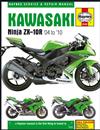
Hardcover - 384 pages - Kawasaki ZX-10R 2004 - 2010 Haynes Owners Service Repair Manual covers the following models: ZX1000C1F 2004 ZX1000C2F 2005 ZX1000D6F 2006 ZX1000D7F 2007 ZX1000E8F 2008 ZX1000E9F 2009 ZX1000FAF 2010Contents: Living With Your Kawasaki ZX-10R Introduction- About This Manual- Identification Numbers- Buying Spare Parts Daily (Pre-Ride) Checks- Engine/Transmission Oil Level Check- Brake Fluid Level Checks- Suspension Steering And Final Drive Checks- Legal And Safety Checks- Tyre Checks Maintenance- Routine Maintenance And Servicing- Specifications- Recommended Lubricants And Fluids- Maintenance Schedule- Component Locations- Maintenance Procedures Repairs And Overhaul- Engine Transmission And Associated Systems- Engine Clutch And Transmission- Cooling System- Fuel And Exhaust Systems- Ignition System- Chassis Components- Steering- Suspension- Final Drive- Brakes- Wheels- Tyres- Frame And Bodywork
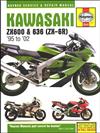
Hardcover - 288 pages - Kawasaki ZX600 636 (ZX-6R) 1995 - 2002 Haynes Owners Service Repair Manual Covers the following models:US models: Kawasaki ZX600F 1995-1997 Kawasaki ZX600G 1998-1999 Kawasaki ZX600H 1998 Kawasaki ZX600J 2000-2002UK and Europe models: Kawasaki ZX600F 1995-1997 Kawasaki ZX600G 1998-1999 Kawasaki ZX600H 1998 (except UK) Kawasaki ZX600J 2000-2001 Kawasaki ZX636A 2002Contents: Kawasaki Zx600 636 (Zx-6r) Maintenance Introduction- Engine/Transmission Oil Level Check- Brake Fluid Level Checks- Specifications- Recommended Lubricants And Fluids- Maintenance Schedule- Component Locations- Maintenance Procedures Repairs And OverhaulEngine Transmission And Associated Systems- Engine Clutch And Transmission- Fuel And Exhaust Systems- Ignition System- Fuel And Exhaust System- Ignition Systems Chassis Components- Frame And Suspension- Final Drive- Brakes- Tyres- Fairing And Bodywork Elec
The bike was in season 10 of Fifth equipment on October 30, 2006.
Bike American track tested the cycle in its October 10, 2006 problem and uploaded listed here inventory outcomes:
60 ft.: 1.713 moments
330 ft.: 4.349 seconds
1/8 mile: 6.447 moments, achieving 117.39 mph
1/4 mile: 9.783 moments, attaining 147.04 mph
2008 saw a up-date. The introduction associated with 2012 ZX-14R spotted a second-generation revision alongside obtaining R designation. A displacement increase which produced even more horsepower, along with three adjustable energy modes and KTRC. Kawasaki grip control and ignition-management system that was raised through the ZX-10R. Also with cosmetic changes and incremental chassis improvements and suspension revised internals. There is additionally a slipper clutch added for the first time. The motor gets cylinder minds with polished harbors and cams with increased raise and longer length. Piston were lighter with additional compression that have cooled by a new oil jet program. More powerful connecting rods and crankshaft and a stronger tensioner and cam string. even though the transmission gets heat treated exterior gears. In addition so that you can result in the bike run cooler, and as a consequence be much more durable, they added a second radiator lover. Larger head pipelines and larger mufflers with a less limiting air conditioning filter all perfect response. Engine cyclist taped Rickey Gadsonâs quarter-mile period of 9.64 seconds at 149.83 miles per hour from a bone-stock bicycle, on a 50-degree morning, at an altitude of 2100 legs. Pattern world recorded a quarter-mile time that created accurate documentation 9.47-second at 152.83 miles per hour, and also struck 60 miles per hour in just 2.6 sec.
The Kawasaki Ninja ZX-11 is a motorcycle which was made out of 1990 to 2001. It had been sold since the ZX-11 Ninja in North America and ZZ-R1100 inside remaining globe. The C-model went from 1990 to 1993 as the D-model ran from 1993 to 2001. The ZX-10 ended up being the predecessor of the ZX-11 Ninja.
Competition for quickest manufacturing bike
With accurate documentation top speeds of 169â176 miles per hour the ZX-11 is the quickest manufacturing motorcycle for six years, from the introduction in 1990 through 1995, when it was exceeded because of the 1996 Honda CBR1100XX. If the bicycle was launched in 1990, the nearest manufacturing bicycle top speeds was 16 km/h slow also it belonged to your ZX-10, the cycle that Kawasaki was replacing because of the ZX-11. The ZX-11 additionally have a ram environment induction program. The 1990 ZX-11 C1 design got a Ram-air intake the first on any production motorcycle. The 1997 ZX-11's quarter-mile time was 10.43 seconds at 131.39 mph.
In 2000 the Kawasaki Ninja ZX-12R is introduced. The ZX-12 ended up being designed to be much more of a pure sportbike. It absolutely was a great deal anticipated since the Suzuki GSX1300R Hayabusa held the title for fastest production cycle when it was launched in 1999. European governing bodies threatened to ban high-speed motorbikes, trusted Kawasaki to de-tune the ZX-12R prior to its release. Beginning in the very end of 1999, a gentlemen's agreement between bigger European and Japanese brands features restricted production bike top speeds to 300 km/h,
In 2002 the Kawasaki ZZ-R1200 was released, which is a hobby tourer plus akin to the ZX-11.
The Ninja ZX-10 ended up being an activity motorcycle produced by Kawasaki motorbikes between 1988 and 1990, an element of the Kawasaki Ninja line. With a high speed of 165 miles each hour, it was the fastest production bike in 1988.
The ZX-10 changed the GPZ1000RX whilst the flagship sportbike from Kawasaki.
The motor had been created as a result of its predecessor's, with similar displacement but 36 mm semi-downdraft CV carburetors and a narrower valve perspective. Motor internals had been changed: Compression ratio was raised to 11.0:1; less heavy pistons and larger valves were utilized.
It had Kawasaki's first aluminum perimeter framework, a build which includes since be standard.
Aerodynamics are claimed become better than the outgoing model's.
Kawasaki developed the design as a result to Honda's introduction of this CBR900RR Fireblade for the 1992 model year. Ahead of the arrival regarding the Fireblade, large-capacity Japanese activities motorbikes have become polarised. Using one side are the 750 cc athletics bicycles, influenced by stamina racing plus the World Superbike Championship. On the other, the "big-bore" 1,000 cc-plus sports-tourers have end up being the all-natural development regarding the efficiency bikes of this preceding twenty years. Basically, the 750s have the maneuvering, the big-bores have the power. Both in groups, Kawasaki ruled. The ZXR750 provided the technology while the results of ultra-expensive racing-homologation designs from Honda and Yamaha at half the cost, therefore outclassed the likewise priced GSX-R750 of that time, which nonetheless featured a perimeter frame and an oil-cooled engine, whilst the ZZ-R1100 held the title of quickest production bike on Earth.
The Fireblade packed a 900 cc engine into a 750 cc athletics bicycle framework. It blended big-bore power with athletics bicycle management, but, crucially, moreover it pioneered meticulous attention to weight-saving build. The Fireblade not only outpowered the 750's, it had been also significantly lighter. This was the detail forgotten or underappreciated by Kawasaki once they set out to establish their Fireblade-beater. In building 1st ZX-9R, Kawasaki combined their particular class-leading big-bore, the ZZR1100, with regards to class-leading 750, the ZXR750, in the place of invest in a completely brand-new design.
The result was a large bike; despite weight-saving measures like magnesium motor covers, their quoted dry body weight ended up being 215 kg, virtually 30 kg thicker than the Fireblade. They made around 125 hp at the back wheel regarding dyno, between 10 and 15 hp significantly more than the Fireblade, but this benefit in energy couldn't make up for its size, body weight and decreased agility. In the place of feel an immediate competition, the ZX-9R had been retained as an even more steady and much more comfortable replacement for the Honda, with an increase of straight-line speed. The road-going bias is clear through increased clipons and more upright sitting opportunities.
Design record
ZX900B
ZX-9R model 1994
The initial ZX-9R might be seen as a ZXR750 integrating several ZZ-R1100 build services. The tires - three-spoke cast aluminum alloy 3.5-inch x 17-inch front and 5.5-inch x 17-inch backside -, the leading forks - totally adjustable 43 mm upside-down KYB - and unbraced fabricated aluminum box-section swingarm with totally flexible remote-reservoir KYB monoshock are direct carry-overs from ZXR. The twin-piston rear Tokico caliper not attached via a torque arm, and clip-on handlebars installed above the top triple clamp, not the following. The four-piston Tokico front calipers and 320 mm front disks are typical into the ZZ-R and also the ZXR.
The frame was a welded aluminium-alloy dual-beam with cast steering head and swingarm endplates, but with steel-tube engine cradles and swingarm-mount endplates extending back again to support the rider's chair and connect the bolt-on subframe, like ZZ-R1100.
The engine displacement ended up being 899 cc. The crankcases, clutch and gearbox had been held more than from the ZXR750, with a longer-throw crank and a bigger-bore, bigger cylinder block for larger capacity. The cylinder mind ended up being externally highly just like the ZXR, also, but incorporated rocker device actuation like ZZ-R1100 as opposed to the ZXR's direct actuation. Redline ended up being 12,000 rpm up against the Fireblades 10,500 rpm. Induction was by 40 mm Keihin CVKD carburettors, plus the motor breathed through a 10-litre airbox provided by double ram-air intakes regarding the nostrils associated with the bicycle, underneath the solitary headlight, via ducts moving back and throughout the framework beams near the steering head, like regarding the ZZ-R.
ZX900B3 and ZX900B4
Detail modifications. Power increasing from 139 to 141 hp. The rear suspension linkage and rear springtime speed had been changed, increasing management. Pillion grab rails are added, the gearboxes were made stronger, and latest six-piston Tokico front side calipers replaced the last model's four-piston devices. The weight of this cycle risen up to 241.7 kg.
ZX900C1 and ZX900C2
System bore, swing and redline stayed unchanged; the rest is completely new. The clutch ended up being changed from hydraulic to cable-operated. The generator is relocated from behind the cylinder towards the more main-stream location during the left end of this crank. There was clearly now no stability shaft. The valvetrain turned to direct valve actuation, and also the cylinder head is plumbed for then-new plug-top ignition coils, replacing more main-stream remote coils and high-tension leads. Particularly, the latest system additionally showcased a Hall-type cam position sensor on fatigue camshaft. Cam place detectors are typically found in combination with digital fuel shot. Once the ZX900C showcased induction by Keihin 40 mm CVKD carburettors, a cam position sensor wasn't essential. Its inclusion could indicate that Kawasaki have designs to incorporate gasoline injection on the system later on. This very first taken place on the 2000 ZX-12R Kawasaki's first fuel-injected sport cycle because the 1981â1985 GPZ1100.But this would not occur about this motor before 2003 introduction regarding the Z1000, which uses a bored-out ex-ZX-9R system.
The framework shed the steel system cradles, but additionally their bolt-on subframe in addition to back ride level adjuster. The swingarm was a fresh unbraced, rectangular-section extruded build. The wheel sizes had been exactly the same, nevertheless the rims were a new, light build. The brake calipers held over, but the discs were small and lighter without preventing energy being suffering. The rear surprise absorber altered from a remote-reservoir to a lighter, more compact piggyback design. The wheelbase dropped 30 mm to 1,410 mm.
New 46 mm right-way-up KYB forks replaced the heavier, though stiffer 43 mm inverted forks in the B design. The front forks were criticised by some european testers for fluttering during hard driving, a phenomenon that was best fixed aided by the 2002 design.
In general, with a factory-quoted dry fat of 183 kg, the C-model weighed less totally fuelled as compared to earliest B-model considered dry.
Aesthetically, this new bike retained the rounded appearance of their forerunner, but became sleeker, with a slimmer tail product and a smaller sized fairing. Because of the smaller system and shorter wheelbase, however, the gasoline container became wider and intruded more about the riding position than before.
The 1998 ZX9r C1 went a tested quarter mile time, in a various other review the 1998 ZX9r C1 ran a tested quarter-mile time.
ZX900E1 and ZX900E2
a remarkable new look was launched for 2000 model, with distinctive twin headlights and an independent ram-air intake replacing the single headlight and integrated consumption associated with C-model. The system gained some horsepower from somewhat shorter length CVRD 40 mm carburettors, a compression ratio increase from a lower timeframe intake cam, which increasing cranking compression. More modifications are directed primarily at dealing with.
The framework was made stiffer through enlarging regarding the forward engine mounting bolts, though this quit the ZX-9R in just an individual forward motor mount on either region of the frame. Further, the rubberized bushings inside top back system mount were altered to alloy. This combined to make the motor's contribution to the stiffness associated with frame/engine unit higher.
The swingarm pivot and wheel spindles had been made larger in diameter, again for lots more rigidity. Enhanced offset regarding triple clamps paid off the path on the front-wheel to really make the steering most nimble. The forks are reduced to save lots of pounds, and rear shock top mount is redesigned to add a ride-height adjuster.
ZX900F1 and ZX900F2
Adjustment toward 2002â2003 ZX-9R included an innovative new tail fairing, just one part front mudguard, losing the traveler get handles therefore the B/C/E model H-bar mirror bracket. Mechanical improvements included a high braced swingarm and rear shock with a part facing fluid reservoir, stiffened frame with relocated solid engine mounts, enhanced path and decreased hand counterbalance, and latest Nissin four-piston caliper brake system and 320 mm discs in front wheel. Slight motor customizations included a return on B/C design design Keihin CVKD carburettor and a 10per cent heavier crankshaft counterbalance by a diminished diameter flywheel reported to greatly help the system twist up faster, boosting reduced and mid-range torque.
Though subtle, California specific products included catalytic converters and carburettors with electric gas take off solenoids. In 2004 the ZX-9R is replaced with all the ZX-10R.
The Kawasaki Ninja ZX-7R had been a bike when you look at the Ninja athletics bike sets from Japanese maker Kawasaki created from 1992 until 2003. They changed the greater amount of race-oriented ZXR750 in 750cc supersports course. They remained mainly unchanged through its production.
Between 1990 and 1995 in america markets the ZXR-750 and ZXR-750R are generally ZX-7 and ZX-7R correspondingly. Beginning with 1996 Kawasaki fallen the ZXR title following the ZX-7R all over the world.
Analysis
The ZX-7R had been raced, gaining 12 AMA superbike championship victories. Kawasaki's path Racing group riders were Eric Bostrom, Doug Chandler and Scott Russell. Doug Toland claimed the 1993 stamina FIM World Championship. Andreas Hofmann claimed the 1997 Macau Grand Prix.
The ZX-7R have a 749 cc in-line four-cylinder, four-stroke system.
The frame applied to the ZX-7R try a lightweight aluminum twin-spar items, designed making use of computer-aided design to enhance power. The rear subframe had been built using steel and aluminum, supplying adequate strength for a pillion traveler whilst maintaining weight to the very least.
The swingarm utilized mainly similar fabrication processes to produce a hollow cast and squeezed aluminum alloy crossbreed swingarm, and also the Uni-Trak back suspension system system features a predominantly lightweight alloy and aluminum construction. The Uni-Trak program was built to supply a progressively stiffer damping and spring rates under compression. A corner suspension device are fully flexible with regards to damping, preload and compression.
The front suspension system located on the ZX-7R includes a totally adjustable 43 mm inverted cartridge hand.
Front brakes are 320 mm semi-floating front side disks and Tokico six-piston calipers. Rear brakes feature a 230 mm disk with a twin-piston compared caliper.
The ZX-7RR differs through the path model with an adjustable head-stock direction, swing arm pivot, additional enhanced adjustability towards the front side and rear suspension system, a solamente cowl with a somewhat various subframe, and 41 mm flat-slide carburetors. In addition has a detailed proportion gear-box installed as traditional and Nissin front brake calipers.
Cycle World have a tested 1/4 mile period of 10.82 moments at 129.68 mph.
Which Bike? Suzuki DR650 vs. Kawasaki KLR650 vs. Honda XR650L In 2023 Which Japanese 650 dual sport suits you? New year, new you, and you need a new bike. If you're looking to get a new six-fiddy, what machine do you want: A DR (like on the left here) or maybe a Honda or a Kawasaki? Photo: Zac Kurylyk
Kawasaki is doubling down on its street-legal KLX230 lineup, literally—from a basic KLX230 S dual sport and KLX230 SM supermoto, we now see two more machines added. For 2026, some markets will now get the Kawasaki KLX230 Sherpa S and KLX230 DF.
Kawasaki has been super-quiet this show season, with a new Z900, Versys 1100, Ninja 1100 and… that’s about it. But get this: They showed a new machine at EICMA that sure looks like a new adventure bike is coming.
Inseam-challenged Sophia gets her hands on the new, lowered Kawasaki KLR650S and rides across the eastern US and Canada to see how it works.
The Kawasaki W230 recalls hot Japanese four-strokes of old, while recycling small-bore moto components made for budget bikes.
The Kawasaki Super Sherpa was a simple, reliable go-anywhere bike that responded well to basic DIY modifications.
The Kawasaki W230 is headed to Europe soon. If it can pass their stringent emissions tests, surely it can also pass the US testing.
Kawasaki hasn’t built a two-stroke dirt bike for the North American market since the late 2000s, when they axed the KLX250. The KLX125 died out a bit before that, and the KE100, their last street-legal two-stroke motorcycle in North America, died out in 2001, at least in the US market. The KDX trail series also died out around the mid-2000s.
It was all sourced from ZX-12R.org , way back before Kawasaki World was born. All the info/mods have been tried and tested by many respected 12r owners back in the day. From my web site front page. Most of the information contained in these web pages has been sourced from other web sites. And has been put here for easier reference.
Hi there, I downloaded these Dynojet Power Commander Custom Maps from the old ZX-12R.org site a few years back. I have put them on my Web Page for who ever would like to use/test them. Thanx Dave. .